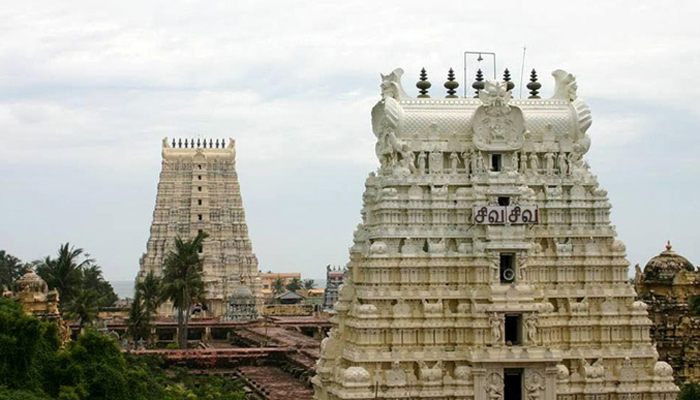Ramanathaswamy Temple is an important pilgrimage site for the followers of Hinduism. It is believed that a visit to this temple washes away one's sins and brings salvation (moksha). Located on an island off the Sethu coast of Rameshwaram, Ramanathaswamy Mandir can be reached via Pamban Bridge across the sea. Being situated in Rameswaram, the shrine is popularly known as Rameshwaram Temple.
Rameswaram is a town in Ramanathpuram district of Tamil Nadu. The town is particularly famous for its religious shrine of Ramanathaswamy. The nearest airport to Rameshwaram is located at Madurai, which lies at a distance of 163 kms. One can easily reach Rameshwaram by taking regular tourist buses or by hiring taxis from all the major cities of Tamil Nadu including Madurai, Chennai and Trichy.
The construction of this temple began in the 12th century; nonetheless it was completed much later, during the reign of various rulers. Rameshwaram Temple is famous for embracing one of the twelve Jyotirlingas (lingam of light) of Lord Shiva. The temple is also accredited for being the southern most 'jyotirlinga' of India. It is believed that at this place Lord Rama offered his gratitude to Lord Shiva.
The Lingam of Ramanathaswamy is the presiding deity of Rameswaram Temple. The religious significance of this shrine has made it, one of the most visited temples of India. Rameshwaram (South) is one of the four major pilgrimage sites of Hindus, the other being Puri (East), Dwarka (West) and Badrinath (north). The main shrine adores the idols of Viswanatha Naicker and Krishnama Naicker.
In the inner section of the Ramalingeshwara, Ramalingam and Vishvalingam are placed side by side. Preserving the words of Lord Rama, Vishvalingam is worshipped before Ramalingam. Maha Shivarathri, Thirukalyanam, Mahalaya Amavasai and Thai Amavasai are the major festivals that are celebrated with gusto and fervor.
Legend
Ramanathaswamy Temple is closely linked with the great epic Ramayana. As per the legend, it is believed that Lord Rama worshipped Lord Shiva here, on his victorious return from Sri Lanka. As the legend goes, Sages (Rishis) counseled Lord Rama (along with Sita and Lakshmana) to install and worship the 'Shivalingam' at this place, to compensate the sin of Brahmahatya (killing of a Brahmin). Lord Rama approved the idea and fixed a favorable time for the installation of Shivalingam.
He sent Lord Hanuman (Anjaneya) to bring a 'lingam' from Mount Kailash. Lord Hanuman could not return in time and it was getting late. Apprehending the situation, Sita herself made a 'linga' of sand and Lord Rama installed the same. When Hanuman came back with the 'linga', the formal procedures of installation were over. Lord Rama consoled the disappointed Hanuman and installed his lingam (Visvalingam) next to Ramalinga. He enhanced the sanctity of lingam by ordaining that the rites would be made first to the Visvalingam.
Twenty Two Wells
Ramanathswamy Temple has twenty two wells in its complex. Being the main attraction of this temple, the wells are also recognized with their distinct properties. All of these wells have water of different taste, temperature, salinity and have curative properties as well. It is said that these wells were made by Lord Rama himself, when he fired arrows in the sand.
Architecture
Stretched over a vast area of 15 acres, Rameswaram Temple is the typical specimen of Dravidian style of architecture. The skyscraping gopurams (spires) truly dominate the skyline of Rameshwaram. The shrine is acknowledged for having the largest temple hallway in India. This pillared corridor extends to 4000 feet in length, embracing more than 4000 pillars. Erected on a raised plinth, granite pillars are intricately carved with beautiful images. A hard fact about this corridor reveals that the rock doesn't belong to the island and it was imported from somewhere across the sea.
Encompassing nine levels, the eastern Rajgopuram (spire) soars to the height of 126 feet. However, the western 'gopuram' is not as high as the eastern 'gopuram', still it is equally captivating. The temple comprises numerous 'mandaps' having small shrines, dedicated to other deities. The colossal image of Nandi (Lord Shiva's Bull) captures the attention, due to its sheer size. It measures 12 feet in its length and 9 feet in its height. High fortifications encircle the temple, making a rectangle along with big pyramidal 'gopura' doorways on every side.
Location : On an island of Rameswaram in Ramanathpuram district, Tamil Nadu
Dedicated to : Sri Ramanathaswamy (Lord Shiva)
Attraction : Twenty two wells
Significance : One of the twelve Jyotirlingas

